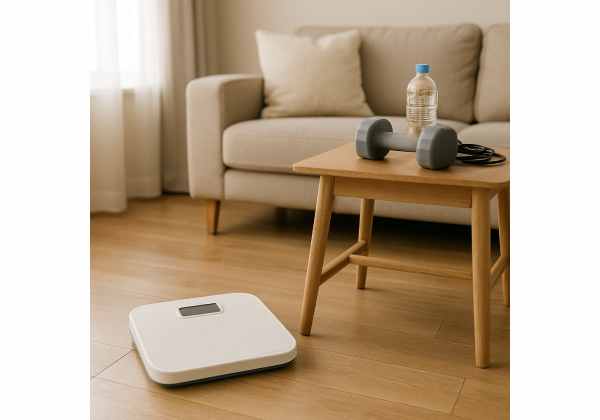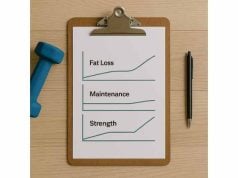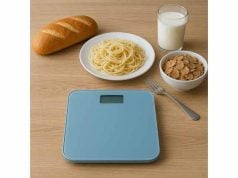
Cutting calories works on paper, then your steps slide, you sit more, and the deficit vanishes. That quiet slide has a name: NEAT—non-exercise activity thermogenesis. It includes every calorie you burn outside intentional workouts: walking to the train, chores, fidgeting, posture. During a diet, NEAT tends to fall without you noticing. This guide shows why it drops, how to measure it, and how to build a day that keeps movement high even when energy is lower. If you are not sure whether a true stall or basic drift is the problem, start with a quick diagnostic from our focused plateau troubleshooting guide before changing your plan.
Table of Contents
- NEAT drop explained
- Measure your NEAT baseline
- Build an all-day movement plan
- Mistakes that crush NEAT
- Sleep, stress and recovery
- When to adjust calories or phase
- Evidence and realistic expectations
- FAQ
NEAT drop explained
NEAT is everything you do outside the gym: walking, standing, carrying groceries, stair climbing, even fidgeting. It’s the largest variable slice of daily energy expenditure and the first to shrink in a calorie deficit. When food goes down, your brain economizes: you choose the elevator, linger in chairs, cut errands, and your small postural muscles switch off more often. None of these choices feel like “less exercise,” but together they erase hundreds of calories per day.
Why NEAT drops during dieting:
- Lower drive to move. Hunger and mild fatigue shift preferences toward sitting and shorter routes.
- Micro-decisions. You still “work out,” but skip a lap around the block, park closer, and outsource chores.
- Hormonal nudges. Leptin and thyroid hormones reflect energy status. As intake falls, your body quietly burns a bit less through unconscious activity.
- Routine compression. Busy periods make you batch tasks and sit longer to “be efficient,” trimming organic movement.
What that looks like in data:
- Step count down 1,000–3,000 per day compared with pre-diet.
- Fewer standing intervals; more uninterrupted sitting blocks.
- Reduced “incidental lifts” (carrying, climbing, yard work).
- Same gym time, yet slower weekly loss because outside-gym calories fell.
NEAT is not just about steps. Two people can show identical step totals yet expend different energy because of pace, posture, terrain, carrying load, and fidgeting. That’s why this article goes beyond a generic “10k steps” target and gives you anchors that protect movement even when motivation dips.
If you need a quick refresher on energy balance before you tune NEAT, skim our simple primer on safe fat-loss fundamentals. Understanding the budget will make these movement levers easier to use.
Key takeaway: Your deficit doesn’t just depend on workouts. The quiet fall in everyday movement is often the reason fat loss stalls. You need a plan that keeps NEAT high when your brain would rather coast.
Measure your NEAT baseline
You can’t fix what you don’t see. A short, honest baseline shows whether NEAT is the missing piece and where to intervene first.
Step 1 — Capture a normal week.
For 7 days, wear a step counter from wake-up to bed. Don’t chase numbers; observe. Note three things daily:
- Total steps (not just “active minutes”).
- Longest sitting block (in minutes).
- Chores, errands, and stairs (yes/no).
Optional but powerful: record standing time if your device tracks it.
Step 2 — Tag context.
At day’s end, write one sentence: “What made today lower/higher?” Examples: back-to-back calls, rain, late commute, kids’ activities, grocery run, yard work, office day vs. home day. Patterns reveal themselves fast.
Step 3 — Compare to pre-diet.
If you have old data, compare averages. Many dieters discover a drop of 1,500–2,500 steps/day, less stair climbing, and an extra hour of continuous sitting.
**Step 4 — Set a floor and ceiling, not a single number.
Pick a floor target you can protect on hard days (e.g., 6,500). Pick a ceiling to prevent overreaching (e.g., 11,000). On high-drive days you’ll hit the upper end; on low-drive days you defend the floor.
Step 5 — Identify your leverage points.
Most people have one of three NEAT bottlenecks:
- Sedentary workdays: long meetings, deep focus blocks, few errands.
- Commute and logistics: drive-heavy days, school runs.
- Evenings at home: couch time that expands after dinner.
Micro-tests to locate drift
- Pomodoro stand test: during a 2-hour desk block, set three standing intervals (60–120 seconds). Did you skip them? That’s drift.
- Errand consolidation test: if you bundle errands into one car loop, your steps shrink. Try a walkable errand instead once this week.
- Dinner-to-bed gap: measure the window between last bite and bed. If it’s 3 hours of couch time, you’ve found a movement slot.
For a deeper review of whether your stall is real, run the two-to-four-week checks in our quick guide to confirm a true plateau. It helps you avoid chasing noise when water or glycogen is the real culprit.
Bottom line: Establish a floor, a ceiling, and your bottleneck. Data turns vague “I should move more” into one or two targeted fixes you can repeat.
Build an all-day movement plan
White-knuckling steps fails. Structure wins. Use anchors, triggers, and defaults so movement happens even when motivation is low.
1) Anchor walks to meals (the “3×10 rule”).
After breakfast, lunch, and dinner, walk 10 minutes. That’s 30 minutes and often 2,000–3,000 steps without “finding time.” If weather is bad, march stairs or pace indoors while listening to a podcast.
2) Install sit-to-stand triggers.
Every 30–45 minutes, stand for 60–120 seconds. Pair with tasks: water refill, printer, quick stretch. Use calendar nudges or a smart-watch alert. Ten of these add meaningful energy burn and reduce stiffness.
3) Commit to one “errand on foot.”
Choose a walkable errand daily: mailbox, corner shop, school pickup hand-off, coffee loop with a colleague. If your area isn’t walkable, create an out-and-back loop from your door and make calls while walking.
4) Make chores count.
Laundry, dishes, vacuuming, and yard work are NEAT gold. Set a 20-minute chore block after work with a timer. Add farther-away parking in big lots and two-trip carries for groceries.
5) Use the commute, even if it’s short.
Park one or two blocks away. If you commute by train or bus, stand for one stop or walk one station early.
6) Default evening routine.
Create a post-dinner ritual: 10-minute walk + kitchen tidy + prepare tomorrow’s lunch. It breaks the couch magnet and helps late-night appetite control.
7) Weekend templates.
Without work structure, weekends sink NEAT. Use a two-hour movement window: morning walk + market + chores. Add micro-adventures (parks, museums, flea markets) that require walking.
8) Pace and posture matter.
Stand tall, walk with a brisk rhythm, and carry light loads when possible. Same steps, higher energy burn.
Two sample days
- Office day
- 07:30: 10-minute loop after breakfast
- 09:30–16:30: stand 90 seconds every 40 minutes (calendar reminders)
- Lunch: 10-minute walk plus one errand on foot
- 17:45: park two blocks away at pickup
- After dinner: 10-minute neighborhood walk + dishes/next-day prep
- Home day
- 08:00: 15-minute brisk walk with coffee
- Work blocks: five stand breaks before noon, five after
- Mid-afternoon: laundry + upstairs carry + 8–12 minutes of yard tidy
- Evening: family stroll or hallway laps during a show
For people who like clear step increments, our practical guide on step upgrades that stick shows how to add 1,000–2,000 steps without formal cardio.
Bottom line: Movement sticks when it’s attached to events you already do—meals, calls, chores, commutes. Build three to five anchors and let them repeat.
Mistakes that crush NEAT
Most NEAT loss isn’t laziness; it’s design. Avoid these common traps that erase your deficit without touching your meal plan.
1) “I’ll make up for it with cardio.”
You won’t. Replacing 2,000 lost daily steps with a single hard session often backfires by increasing hunger and couch time afterward. Keep workouts, but defend your NEAT floor first. For a quick triage of other hidden drains, see our streamlined plateau checklist.
2) All-or-nothing step goals.
A single number (e.g., 10k) makes low-energy days feel like failure. Use a floor/ceiling band (e.g., 6.5k–11k). Floors protect consistency; ceilings prevent boom-bust cycles.
3) Giant sitting blocks.
Two or three 90-minute seated streaks erase the benefit of an otherwise good day. Set a standing trigger to break each block, even if you don’t add steps.
4) Over-automating your life.
Groceries delivered, robot vacuum, curbside pickup—great tools, but they drain NEAT. Reclaim one physical errand per day.
5) Diet fatigue mistakes.
Very low calories make you listless and sleep worse, which shrinks NEAT further. If your gym performance and steps are slipping for two weeks, you may need a diet break—details in Section 6.
6) Weekend collapse.
Structure disappears, alcohol shows up, and steps nosedive. Protect one movement window (morning or afternoon) with a repeating plan: walk + chores + fun on foot.
7) Ignoring clothing and shoes.
Uncomfortable shoes or restrictive clothing make spontaneous walking less appealing. Keep walk-friendly shoes at work or by the door and you’ll move more without thinking.
8) Tracking tunnel vision.
Devices miss fidgeting, posture, carrying, and some chores. If your steps look fine but weight loss stalls, audit sitting time and errands—the untracked pieces.
Fix in one sentence: Defend your NEAT floor every day with anchors, and stop asking workouts to do NEAT’s job.
Sleep, stress and recovery
Sleep debt and stress flatten the very drive that powers NEAT. Repair these, and your daily movement rebounds with less effort.
Sleep first
- Aim for 7–8 hours with a consistent sleep/wake window.
- Move caffeine earlier; keep the last dose 8 hours before bed.
- Add a wind-down cue 45–60 minutes before lights out: dim lights, stretch, light reading.
- If nights are noisy or hot, protect cooling and darkness—small comfort upgrades yield real movement the next day.
Stress and decision fatigue
- High stress favors sitting and scrolling. Protect walk-and-talk calls and post-meeting loops (5–10 minutes).
- Use short finish lines during heavy days: when you complete task X, take a 3-minute lap. Your brain loves earned breaks.
Training that supports NEAT
- Keep strength training to 2–4 sessions/week, 45–60 minutes, focused on big lifts. Crushing yourself daily reduces NEAT by making you guard every step.
- Place hard workouts away from your longest desk blocks so you do not spend the rest of the day glued to a chair.
For deeper repair strategies tying sleep to fat loss and appetite control, see our plain-English guide on sleep, cortisol and stalled loss. Better sleep often raises NEAT without extra willpower.
Bottom line: Recovery isn’t a luxury; it’s the battery for NEAT. When sleep and stress are handled, movement becomes automatic again.
When to adjust calories or phase
Sometimes the smartest way to protect NEAT is to change your phase or nudge calories. Pushing harder on low fuel often backfires.
Choose a 10–14 day diet break (eat at estimated maintenance) if three or more apply:
- Steps have fallen >1,500/day for two weeks despite anchors.
- Workouts feel flat; you are dropping reps or loads.
- Sleep is poor and you think about food constantly.
- Your mood is short, and evenings spiral into grazing.
How to run it:
- Raise to maintenance calories (use your current average intake + intended loss rate × 500 as a quick estimate).
- Keep protein high (≥ 1.6 g/kg/day).
- Maintain your NEAT anchors and training.
- Review two-week averages before returning to a deficit.
Small calorie nudges (100–200 kcal/day)
- If you are close to goal and NEAT is collapsing, a slight bump can restore steps and adherence.
- Add calories to dinner and evening snack (protein + carbs or protein + fat), then watch steps and hunger for 7–10 days.
Macro shifts without extra calories
- If richer meals feel more satisfying, move 10–15 g fat from daytime snacks to dinner and trim carbs equivalently.
- If training is flat, shift 20–40 g carbs to pre-workout or dinner the night before morning sessions.
When you need a clear decision tree that balances calories, macros, and movement, walk through our practical guide on when to raise calories so you protect NEAT without losing momentum.
Key idea: Your deficit should leave enough energy for life. If NEAT keeps falling, change the inputs—phase, calories, or macro timing—so your day stays active.
Evidence and realistic expectations
Set expectations correctly and NEAT becomes your quiet superpower rather than a moving target.
How big is NEAT?
It can vary by hundreds of calories per day between people of the same size—and by 100–300 calories within the same person across different phases of a diet or workweek. That’s enough to make a measurable difference in weekly fat loss.
What change should you expect?
- Adding 2,000 steps/day typically burns 60–100 extra calories, depending on size, pace, and terrain. Not huge, but over 6–8 weeks it’s meaningful—especially when paired with reduced sitting time and light carrying.
- Improving post-meal movement (3×10 minutes) often lowers evening grazing by improving mood and appetite control—an indirect but powerful win.
What success looks like in real life
- Your floor/ceiling band becomes routine: 6.5k on hard days, 10–11k on easier ones.
- Sitting blocks shrink; you naturally stand or walk during calls.
- You keep two weekend movement windows most weeks.
- Fat loss resumes at your intended pace without needing punishing cardio.
How long to judge a change?
Two weeks. NEAT habits stabilize with practice. Review two 7-day averages before you add more levers.
If you want to separate fluid and glycogen noise from true fat loss while you test NEAT fixes, use our plain-language explainer on water, glycogen and sodium so short spikes don’t derail your plan.
Bottom line: Expect modest daily improvements that compound, not dramatic single-day burns. NEAT is about consistency and design, not heroics.
FAQ
What counts as NEAT and what doesn’t?
NEAT includes all movement outside intentional exercise: walking, standing, chores, carrying loads, posture changes, and fidgeting. Planned workouts—lifting, running, classes—are not NEAT. Both matter, but NEAT is the larger daily variable and the easiest to maintain with anchors.
How many steps should I aim for during a cut?
Use a band, not a single number. Set a floor you can defend on hard days (for many, 6,000–8,000) and a ceiling that feels easy on good days (often 10,000–12,000). Hold the band for two weeks, then adjust by 1,000–2,000 based on results and lifestyle.
Why did fat loss stall even though I still work out?
Because workouts are a small part of the day. During dieting, you often sit more, walk less, and fidget less. That NEAT drop can erase your deficit. Rebuild movement with post-meal walks, stand breaks, and one walkable errand daily before cutting more calories.
Can I replace low NEAT with extra cardio?
Not reliably. Hard cardio sessions can increase hunger and lead to more sitting later. Keep training, but protect NEAT first with daily anchors. If you want extra burn, choose easy zone activities (brisk walks, light cycling) that don’t crush recovery.
What should I do on very low-energy days?
Defend your floor only: three 10-minute walks after meals and three stand breaks per work block. Keep meals steady, hydrate, and go to bed on time. One low-drive day won’t derail you if the structure stays intact.
When is it time to raise calories?
If steps fall >1,500/day for two weeks, sleep worsens, workouts fade, and you’re thinking about food constantly, consider a 10–14 day diet break at maintenance or a 100–200 kcal bump. Keep NEAT anchors while you reassess trends.
References
- Does adaptive thermogenesis occur after weight loss in adults? A systematic review (2022) (Systematic Review)
- The Acute Effects of Interrupting Prolonged Sitting Time in Adults with Standing and Light-Intensity Walking on Biomarkers of Cardiometabolic Health in Adults: A Systematic Review and Meta-analysis (2022) (Systematic Review & Meta-analysis)
- A comparison of acute glycaemic responses to accumulated or single bout walking exercise in apparently healthy, insufficiently active adults (2020) (RCT)
- Intermittent energy restriction improves weight loss efficiency in obese men: the MATADOR study (2018) (RCT)
- Impact of calorie restriction on energy metabolism in humans (2020) (Review)
Disclaimer
This article provides general education about daily movement and energy balance. It is not medical advice and does not replace care from a qualified clinician. If you have medical conditions, chronic pain, mobility limitations, or take medications that affect energy or appetite, seek personalized guidance before changing your plan.
Share and follow
If this guide helped you build a movement day that lasts, share it with someone who is struggling to keep steps up during a cut. For more practical checklists and templates, follow us on the social network you use most—Facebook, X (formerly Twitter), or another platform you prefer.










